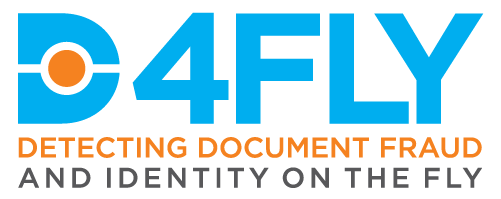After two years of reduced travel activities due to the pandemic, the re-opened transportation hubs welcomed us back with thousands of passengers . Three years ago, the EU funded the Horizon 2020 research project, D4FLY, which started with the aim of improving document and identity verification techniques and thus developing border crossing solutions that are faster, more convenient and provide authorities with higher levels of security and accuracy in verification results.
On June 22nd 2022, the final demonstration of the project results took place in Portsmouth, United Kingdom. This demonstration focused on busy border crossing situations where many travellers must be checked. It used a highly automated border checking process with a biometric corridor (corridor scenario), as well as a border checking process using a smartphone in a coach for the identity verification (coach scenario).
The corridor scenario can be implemented in airports, cruise ships or train stations and consists of two components – the traveller’s self-enrolment kiosk and the verification corridor. The corridor allows seamless biometric verification on the move for travellers. Both the corridor and the kiosk are equipped with innovative presentation attack detection technologies.
The coach scenario allows verification in crowded and confined spaces without a fixed border control post. This set-up also combines two components – the traveller’s self-enrolment kiosk and an app that allows border guards to use a smartphone as a verification device on a coach.
In addition to these two scenarios a smartphone app was presented that uses smartphone sensors as an additional source for biometric verification.
The two scenarios used multiple biometric features in enrolment and verification. The following modalities were combined in the D4FLY solution: 2D, 3D and thermal face, iris and somatotype.

The Presentation Attack Detection developed in the D4FLY project cover various attack scenarios such as: liveness detection with thermal image or blood flow analysis, fake iris detection and morphed image detection.
The solutions presented in Portsmouth combined developments by the D4FLY partners: Norwegian University of Science and Technology, University of Reading, Military University of Technology Warsaw, Fraunhofer Heinrich-Hertz-Institut and Veridos.
In order to collect valuable feedback on the solutions developed by the D4FLY project, representatives from European Commission, EU-Lisa and Frontex were invited to participate in the final demonstration in Portsmouth. The participants went through all scenarios as a traveller using the self-enrolment kiosk, being verified in a coach and walking through the corridor, as well as border guards using the equipment to support authority personnel in their daily tasks.
Support during the preparation and on site was provided by the UK Home Office, end-user partner in the D4FLY project, and the Portsmouth Port authorities.
The project demonstrated working prototypes and received very positive feedback from the participants.
The project results related to the improved document verification technologies were already presented in the final demonstration in Amsterdam, Netherlands in April 2022 (see related News).
All research and development tasks for the project are now finalised and the partners are focusing on writing the final deliverables and reports. The project will formally end on August 31st 2022.

